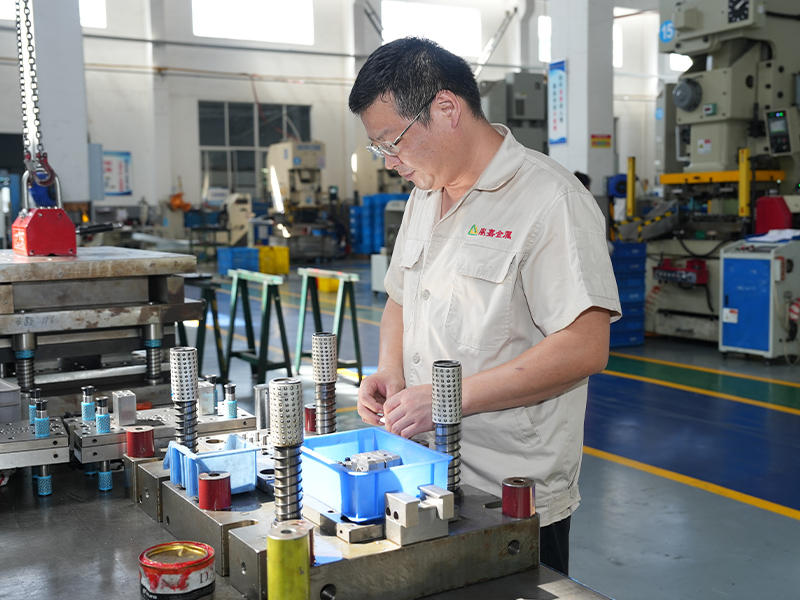1. Definition and Basics of Iron Stamping Parts
1.1 What are Iron Stamping Parts?
Iron stamping parts are components shaped from iron sheets or coils through the stamping process. This process involves using dies and presses to apply force, causing the iron material to deform plastically and take on the desired shape. The iron used can vary, including mild steel, which is known for its good formability and weldability, and can be easily shaped into various parts. For example, in the automotive industry, many body panels and structural components are made from mild steel through stamping.
1.2 The Significance of Iron in Stamping
Iron is a preferred material for stamping due to several reasons. Firstly, it has relatively high strength, which is crucial for parts that need to withstand mechanical stress. For instance, in machinery manufacturing, iron stamping parts are used in gears and shafts, where they must endure significant forces during operation. Secondly, iron is cost - effective compared to some other metals like copper or aluminum. This cost - advantage makes it suitable for large - scale production in industries such as consumer goods, where cost control is a major factor.
2. The Production Process of Iron Stamping Parts
2.1 Material Preparation
The process begins with carefully selecting the appropriate iron material. The thickness and quality of the iron sheets are crucial factors. For example, thinner sheets are often used for parts that require less strength but more intricate shapes, like small electrical components. Once selected, the sheets are cut to the required size and shape, usually using shearing machines. This pre - cutting step ensures that the material is ready for the subsequent stamping operations.
2.2 Stamping Operations
2.2.1 Punching
Punching is one of the primary stamping operations. In this process, a punch (a male die) is forced through the iron sheet against a die (a female die), creating holes or cut - out shapes. For example, in the production of ventilation grilles, punching is used to create the numerous small holes. The accuracy of the punching process is highly dependent on the quality of the dies and the precision of the press.
2.2.2 Bending
Bending is used to shape the iron sheet into angles or curves. The iron sheet is placed between a punch and a die, and the punch applies force to bend the material. This operation is commonly seen in the manufacturing of brackets and frames. For example, the brackets used to support electrical equipment are often made by bending iron sheets. The bending angle and radius need to be carefully controlled to meet the design requirements.
2.2.3 Deep Drawing
Deep drawing is a more complex stamping operation used to create three - dimensional parts. A flat iron sheet is drawn into a die cavity to form a cup - like or more complex shape. Automotive fuel tanks are often made through deep drawing of iron sheets. This process requires precise control of the blank - holding force, punch speed, and die design to prevent defects such as wrinkling or tearing of the material.
2.3 Post - Stamping Treatments
2.3.1 Deburring
After stamping, the parts often have sharp edges and burrs. Deburring is necessary to remove these imperfections. This can be done through mechanical methods such as grinding or using deburring tools. Deburring not only improves the safety of handling the parts but also enhances their appearance and functionality. For example, in parts that need to be assembled, burrs can interfere with proper fitting.
2.3.2 Surface Finishing
Surface finishing is carried out to improve the corrosion resistance and appearance of the iron stamping parts. One common method is electroplating, where a thin layer of metal such as zinc or nickel is deposited on the surface of the iron part. Zinc plating, also known as galvanizing, is widely used to protect iron parts from rusting, especially in outdoor applications. Another option is painting, which can provide both protection and a decorative finish.
3. Applications of Iron Stamping Parts
3.1 Automotive Industry
In the automotive industry, iron stamping parts are used extensively. Body panels, such as doors, hoods, and fenders, are made from iron sheets through stamping. These parts need to be lightweight yet strong to ensure the safety and performance of the vehicle. Additionally, structural components like chassis parts and suspension brackets are also iron stamping parts. For example, the chassis of a car is made up of multiple stamped iron components that provide the necessary rigidity and support.
3.2 Electronics Industry
The electronics industry uses iron stamping parts in various applications. For instance, in the manufacturing of electronic enclosures, iron sheets are stamped into the required shapes to house electronic components. These enclosures need to be well - formed to protect the delicate electronics inside from external factors such as dust and moisture. Iron stamping parts are also used in the production of heat sinks, which help dissipate heat generated by electronic devices. The precise shapes of heat sinks are achieved through stamping to maximize their heat - transfer efficiency.
3.3 Machinery and Equipment Manufacturing
In machinery and equipment manufacturing, iron stamping parts play a vital role. Gears, which are essential components in many machines, are often made from iron through stamping and subsequent machining processes. The stamping process helps create the basic shape of the gear, and then machining operations are carried out to achieve the required precision. Other parts such as machine frames and brackets are also commonly made of iron stamping parts. These parts need to be strong enough to support the various components of the machinery and withstand the mechanical stresses during operation.
4. Advantages of Iron Stamping Parts
4.1 High Production Efficiency
The stamping process is highly efficient for mass production. Once the dies are designed and set up, a large number of parts can be produced in a short time. Modern presses can operate at high speeds, with some capable of performing hundreds of stamping operations per minute. This high - speed production makes iron stamping parts suitable for industries with high - volume demands, such as the automotive and consumer goods industries.
4.2 Cost - Effectiveness
As mentioned earlier, iron is a relatively inexpensive material. In addition to the low material cost, the stamping process itself is cost - effective for large - scale production. The use of dies allows for consistent production of parts with minimal material waste. Once the initial investment in die - making is made, the cost per part decreases significantly as the production volume increases. This cost - effectiveness makes iron stamping parts an attractive option for manufacturers looking to keep production costs down.
4.3 Good Dimensional Accuracy
Stamping can achieve high dimensional accuracy. The precision of the dies and the control of the stamping process ensure that the produced parts meet the required dimensional tolerances. This accuracy is crucial for parts that need to be assembled with other components. For example, in the automotive industry, parts such as engine mounts need to have precise dimensions to ensure proper fit and function within the engine compartment.

5. Challenges and Solutions in Iron Stamping
5.1 Material - Related Challenges
5.1.1 Variability in Material Quality
The quality of iron materials can vary from batch to batch. This can lead to differences in the formability and mechanical properties of the material, affecting the stamping process. For example, if the iron sheet has inconsistent hardness, it may cause uneven deformation during stamping. To address this, manufacturers should source materials from reliable suppliers and conduct thorough material testing before production. Implementing a quality control system for incoming materials can help ensure that only materials meeting the required standards are used.
5.1.2 Material Thickness Variations
Slight variations in the thickness of iron sheets can also pose problems in stamping. Thicker or thinner areas in the sheet can lead to inconsistent results, such as differences in the depth of drawn parts or the accuracy of punched holes. To mitigate this, manufacturers can use advanced measurement techniques to detect thickness variations in the material before stamping. Additionally, adjusting the stamping parameters, such as the punching force or blank - holding force, based on the measured thickness can help improve the quality of the final parts.
5.2 Die - Related Challenges
5.2.1 Die Wear
Die wear is a common issue in the stamping process. The repeated contact between the die and the iron material during stamping can cause the die surface to wear out over time. This can lead to a loss of dimensional accuracy in the stamped parts and an increase in the occurrence of defects such as burrs. To reduce die wear, die materials with high hardness and wear resistance, such as tool steels, are often used. Additionally, applying surface coatings to the dies, such as titanium nitride (TiN) coatings, can further improve their wear resistance. Regular die maintenance, including cleaning and polishing, is also essential to extend the die's lifespan.
5.2.2 Die Design Complexity
Designing dies for complex - shaped iron stamping parts can be challenging. The die needs to be designed in such a way that it can accurately form the desired shape while ensuring proper material flow during stamping. For parts with intricate geometries, multiple stamping operations may be required, which adds to the complexity of die design. To overcome this, computer - aided design (CAD) and computer - aided engineering (CAE) tools are used. These tools allow designers to simulate the stamping process, analyze the material flow, and optimize the die design before manufacturing the actual die.
6. Future Trends in Iron Stamping Parts
6.1 Advanced Material Applications
As technology advances, new types of iron - based materials with improved properties are being developed for stamping applications. For example, advanced high - strength steels (AHSS) are becoming increasingly popular in the automotive industry. These steels offer higher strength - to - weight ratios, which can help reduce vehicle weight while maintaining safety. In the future, we can expect to see more widespread use of such advanced materials in iron stamping parts, leading to lighter and more fuel - efficient products in various industries.
6.2 Automation and Precision in Stamping
Automation is set to play a significant role in the future of iron stamping. Automated stamping lines can improve production efficiency, reduce labor costs, and enhance the consistency of part quality. Robots can be used to load and unload materials, and advanced sensors can monitor the stamping process in real - time, making adjustments as needed to ensure optimal performance. Additionally, the use of precision - controlled presses and advanced die - making techniques will continue to improve the dimensional accuracy of iron stamping parts, enabling the production of even more complex and high - quality components.
6.3 Sustainable Stamping Practices
With the growing emphasis on environmental sustainability, the iron stamping industry is also moving towards more eco - friendly practices. This includes reducing material waste by optimizing stamping processes and recycling scrap iron. Manufacturers are also exploring the use of alternative energy sources in their production facilities to reduce their carbon footprint. In the future, sustainable stamping practices are likely to become a standard requirement, and companies that embrace these practices will have a competitive advantage in the market.














